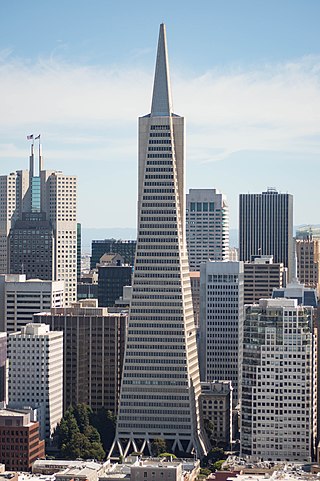
The Transamerica Pyramid is a pyramid-shaped 48-story modernist skyscraper in San Francisco, California, United States, and the second tallest building in the San Francisco skyline. Located at 600 Montgomery Street between Clay and Washington Streets in the city's Financial District, it was the tallest building in San Francisco from its completion in 1972 until 2018 when the newly-constructed Salesforce Tower surpassed its height. The building no longer houses the headquarters of the Transamerica Corporation, which moved its U.S. headquarters to Baltimore, Maryland. The building is still associated with the company by being depicted on the company's logo. Designed by architect William Pereira and built by Hathaway Dinwiddie Construction Company, the building stands at 853 feet (260 m). On completion in 1972 it was the eighth-tallest building in the world. It is also a popular tourist site. In 2020, the building was sold to NYC investor Michael Shvo, who in 2022 hired Norman Foster to redesign the interiors and renovate the building.

City Lights is an independent bookstore-publisher combination in San Francisco, California, that specializes in world literature, the arts, and progressive politics. It also houses the nonprofit City Lights Foundation, which publishes selected titles related to San Francisco culture. It was founded in 1953 by poet Lawrence Ferlinghetti and Peter D. Martin. Both the store and the publishers became widely known following the obscenity trial of Ferlinghetti for publishing Allen Ginsberg's influential collection Howl and Other Poems. Nancy Peters started working there in 1971 and retired as executive director in 2007. In 2001, City Lights was made an official historic landmark. City Lights is located at 261 Columbus Avenue. While formally located in Chinatown, it self-identifies as part of immediately adjacent North Beach.
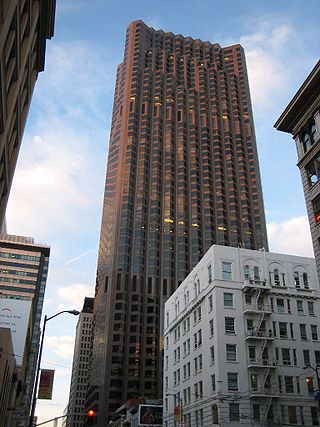
555 California Street, formerly Bank of America Center, is a 52-story 779 ft (237 m) skyscraper in San Francisco, California. It is the fourth tallest building in the city as of February 2021, and in 2013 was the largest by floor area. Completed in 1969, the tower was the tallest building west of the Mississippi River until the completion of the Transamerica Pyramid in 1972, and the world headquarters of Bank of America until the 1998 merger with NationsBank, when the company moved its headquarters to the Bank of America Corporate Center in Charlotte, North Carolina. It is currently owned by Vornado Realty Trust and The Trump Organization.

The Embarcadero is the eastern waterfront of Port of San Francisco and a major roadway in San Francisco, California. It was constructed on reclaimed land along a three mile long engineered seawall, from which piers extend into the bay. It derives its name from the Spanish verb embarcar, meaning "to embark"; embarcadero itself means "the place to embark." The Central Embarcadero Piers Historic District was added to the National Register of Historic Places on November 20, 2002.

Washington Square is an American park in the North Beach district of San Francisco. It was established in 1847 and is one of the city's first parks. The park is bordered by sidewalk cafes and restaurants such as Mama's (restaurant) and Park Tavern restaurants and the Liguria Bakery, as well as Sts. Peter and Paul Church.
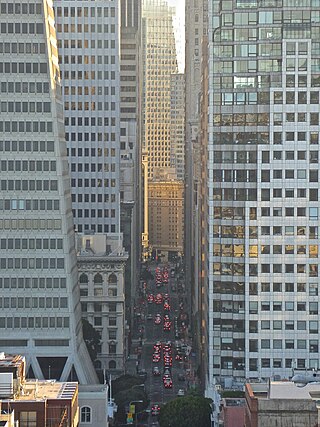
Montgomery Street is a north-south thoroughfare in San Francisco, California, in the United States.

The Palace Hotel is a landmark historic hotel in San Francisco, California, located at the southwest corner of Market and New Montgomery streets. The hotel is also referred to as the New Palace Hotel to distinguish it from the original 1875 Palace Hotel, which had been demolished after being gutted by the fire caused by the 1906 San Francisco earthquake.
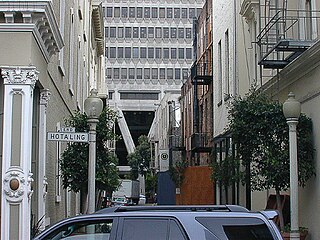
Jackson Square Historic District is an area in downtown San Francisco, California. It dates back to the city's earliest years and the 1849 gold rush, and is known for its historic commercial buildings in the classical revival and Italianate styles.

Nancy Joyce Peters is an American publisher, writer, and co-owner with Lawrence Ferlinghetti of City Lights Books and Publishers in San Francisco until Ferlinghetti's 2021 death.

Niantic was a whaleship that brought fortune-seekers to Yerba Buena during the California Gold Rush of 1849. Run aground and converted into a storeship and hotel, she was a prominent landmark in the booming city for several years. The site of Niantic beside the Transamerica Pyramid is now a California Historical Landmark. Artifacts excavated in 1978 and the ship's log from her last voyage are on display in the San Francisco Maritime Museum.

The Club Fugazi is a small theater and nightclub located in the North Beach district at 678 Green Street, San Francisco, California.
Halleck, Peachy & Billings was one of the leading early law firms in San Francisco, California and specialized in land cases. The firm was organized by Frederick H. Billings and Archibald Carey Peachy in 1849, who were joined soon after by Henry Wager Halleck. Halleck, Peachy & Billings was employed by claimants in the settlement of titles to Mexican land grants. The firm dissolved in 1861 after Halleck returned to military life and left California.
John R. Beckett (1918–2010), an American businessman, was president and chairman of the board of Transamerica Corp. from 1960 to 1983.

The Bank of Lucas, Turner & Company, also known as Sherman's Bank, is a historic building that was formerly a bank building, located at 800–804 Montgomery Street in Jackson Square in San Francisco, California.

The Ritz-Carlton Club and Residences is a 312-foot (95 m) luxury residential skyscraper in the Financial District of San Francisco, California. The residences are built atop the historic Old Chronicle Building, sometimes called the de Young Building, which was constructed in 1890. It is the first skyscraper built in California.

The Tin How Temple is the oldest extant Taoist temple in San Francisco's Chinatown, and one of the oldest still-operating Chinese temples in the United States. It is dedicated to the Chinese sea goddess Mazu, who is known as Tin How in Cantonese.
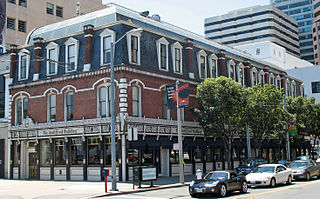
The Audiffred Building is a three-story historic commercial building in San Francisco, California, United States, formerly the location of waterfront bars and of the headquarters of a seamen's union, and now housing Boulevard restaurant. It is City of San Francisco Landmark number 7, and was listed on the National Register of Historic Places in 1979.

The Fugazi Bank Building, also known as the Fugazi Banca Popolare Operaia Italiana Building, and Old Transamerica Building, is a historic commercial building built in 1909, and located at 4 Columbus Avenue in the Jackson Square Historic District of San Francisco, California.

The Colombo Building, also known as the Drexler Building or Drexler-Colombo Building, is a historic commercial building built in 1913, and is located at 1–21 Columbus Avenue in the Jackson Square Historic District in San Francisco, California.



















